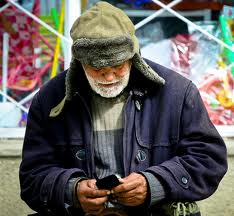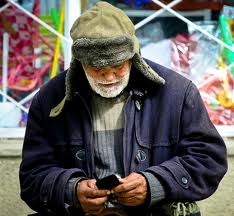 Social media giving homeless a hand up rather a handout
Social media giving homeless a hand up rather a handout
“Social media is the reason I was moved out of homelessness,” Plasschaert said. “The government agencies, shelters and others were not the reason I was placed in housing.”
In an article that will change common perceptions DeseretNews explains….Plasschaert isn’t alone. Nonprofit groups, aid organizations and advocates are increasingly using social media to connect with the homeless. The homeless also put a high value on the devices that keep them connected.
A 2011 study through the University of Southern California School of Social Work found that 62 percent of homeless teens had a phone, a data plan and that they viewed the device as important for them as food. While the study focused on teens, homeless advocate Mark Horvath says those numbers likely apply to the adult homeless as well.
Known on Twitter as @HardlyNormal, Horvath founded a nonprofit group called Invisible People and pioneered a concept he calls virtual case management after his own ordeal with homelessness. While typical case management involves regular office visits, sometimes with multiple caseworkers across multiple aid organizations, virtual case management can reach the homeless or those in crisis anytime, so long as they have a cellphone.
“Hypothetically, the idea is that if a person is hungry in Phoenix, a nonprofit would be listening on Twitter,” Horvath said. “People talk about affordable technology in the context of Africa. We’ve got Third-World conditions right here.”
Horvath first experienced the power of social media four years ago while tweeting with a woman in the Midwest.
“She would go to bed in an alley in Chicago and she would tweet, ‘You’re all with me, I don’t feel alone,’ ” Horvath said. “I thought how powerful is that?”
Horvath took to Twitter with a mission: Find, counsel and direct as many homeless people as possible to help.
“In five-10 years, virtual case management will be a common term,” Horvath said. “But right now, people think I’m crazy.”
A voice
Kara Zordel knows Horvath’s approach works because she uses Twitter on a daily basis as the executive director of San Francisco-based nonprofit Project Homeless Connect to make a difference in a city where there are more than 7,000 living on the streets.
It started with socks and shoes.
“We have so many homeless with diabetes who need clean socks and shoes to keep them out of the emergency room,” Zordel said. “We started thinking, if people in the community just knew about it, they would do something.”
Using Twitter, the program gets clients needed donations.
One example? Wheelchairs. They get stolen from clients two to three times a month, Zordel said, and these clients often call from the sidewalk.
“If they call us, we can get them a wheelchair right then, saving the community time and money and engaging them to get off the streets,” Zordel said.
A major tool for success is access to phones for clients. Through the Federal Communications Commission’s Lifeline Program, more than 12 million people have received wireless phones. Begun in 1985 to get home phones to low-income families, the program has expanded to cellphone distribution.
Horvath and Zordel both say engagement is key to ending homelessness — made much easier with cellphones.
“Without a cellphone right now, you really can’t survive. If by giving someone a phone, we’re able to keep them engaged, that’s the first step to ending homelessness,” Zordel said. “We’ve never had anyone come back and say they lost their phone. Ever.”
“If you’re going to be homeless, what are the two things you’re going to take with you? Your laptop and your iPhone. We expect people in poverty to live in a certain way and be happy with whatever we give them. But the truth is, everyone should have technology,” Horvath said.
For Zordel, Twitter also gives the homeless a chance to network with nonprofits, shelters and even other homeless people who can help. It also makes them visible in a new way.
“[It gives them] a voice,” Zordel said. “We will all know somebody who will fall on hard times. When they start to understand the issue, they see them as a human being. When you hear a person’s voice, it’s impossible to look away.”
A connection
“Sitting on the tracks, waiting for the next train, ready to end it all. Goodbye world.”
Not long ago, there wasn’t much personnel with Toronto’s public transit authority could do when suicidal people offer tweeted a farewell while standing on the train tracks or before jumping in front of a train.
After seeing Horvath’s outreach on Twitter and his work with some of the homeless in Canada, crisis intervention specialist Anne Marie Bratten and Toronto police officer Scott Mills adapted Horvath’s idea for crisis response. They call it Real Time Crisis.
When rail workers alerted Bratten about the tweet, she was able to connect with the woman via Twitter immediately, eventually talking her off the tracks.
The instant connection Twitter offers is essential, Bratten said.
“There are times when there is no support. The idea with this is to be there with them in real time. If I can connect with them right away, I can keep that person safe,” Bratten said.
Engagement and connection are what many people — homeless, suicidal or otherwise in need of help — are looking for.
“Whether you’re talking to your bartender or your priest, everyone needs somebody to talk to,” Horvath said. “If your social network has been under a bridge, moving into housing can be scary and a lot of nonprofits don’t have the structure to come see clients every day. But online, [the social connections] are amazing.”
The homeless aren’t the only group hoping to connect. Everyday people who see the homeless on the streets are looking for a deeper connection, too.
HandUp, a San Francisco-based startup company, networks with nonprofits like Project Homeless Connect to funnel donations to an individual homeless person via a caseworker for anything from food to medical care. Donors can send an email or text. Many donors have ongoing conversations with HandUp clients, says Rose Broome, founder of HandUp.
“They can write back,” Broome said. “There’s something about seeing that connection that’s like, ‘Wow, some barriers are being broken down.’ ”
Broome said she thinks people want to have certainty that what they give helps.
“Donors want more of a way to give directly and know what’s happening. So it’s not just, ‘I gave $20,’ it’s ‘I gave $20 that helped a person get a transit pass to get to their appointments this week,’ ” Broome said.
Thanks to social media, Horvath might be getting closer to his goal one Twitter connection at a time.
In one of Horvath’s videos, Plasschaert looks like a kid waiting to blow out birthday candles while her caseworker goes over housing paperwork. It’s the culmination of a journey that began with a connection on social media.
“Without Twitter, I wouldn’t be standing here,” she told a crowd at a 2012 social media conference in New York. “I would be sleeping on the streets.”
A pen stroke later, Apartment 2 becomes home sweet home.
“An address,” Plasschaert marvels. “Wow.”
Email: chjohnson@deseretnews.com Twitter: ChandraMJohnson
Tags: Anti-poverty strategies, Homelessness, Mobile phones

